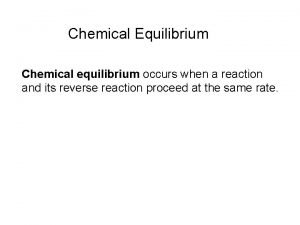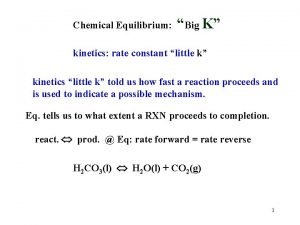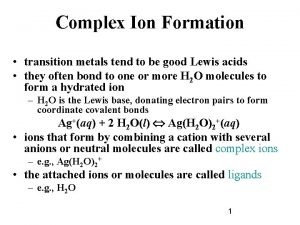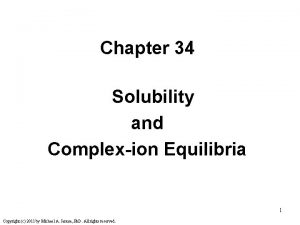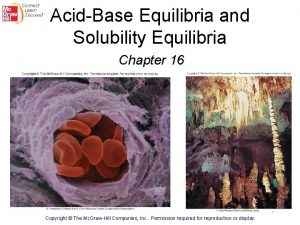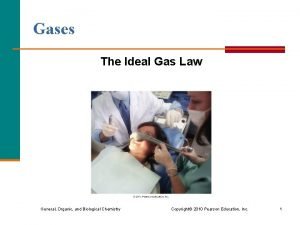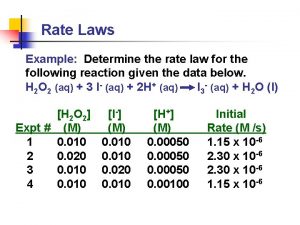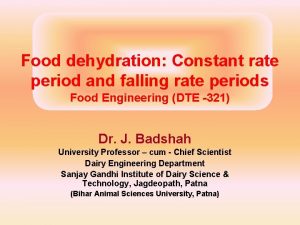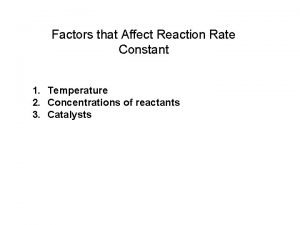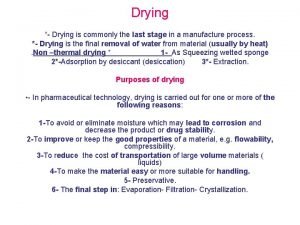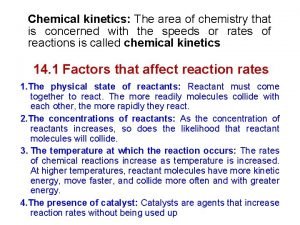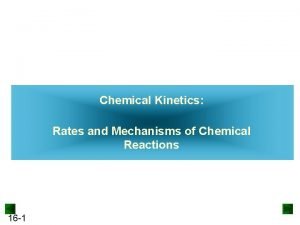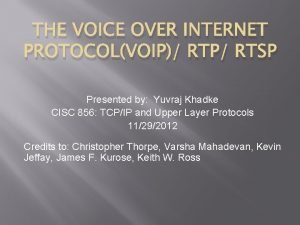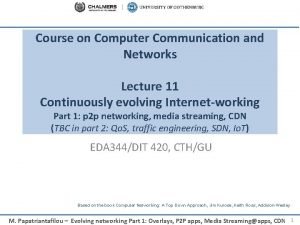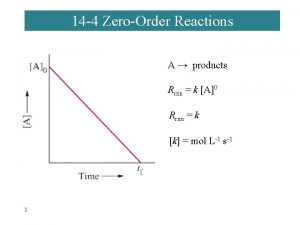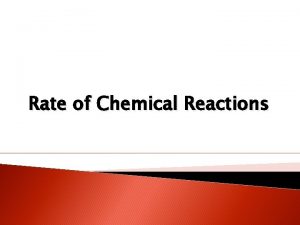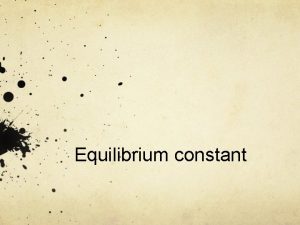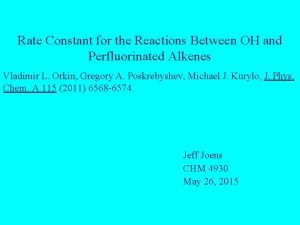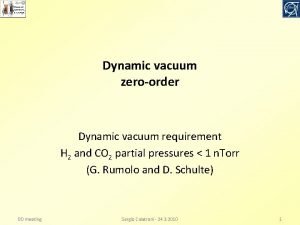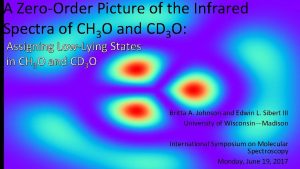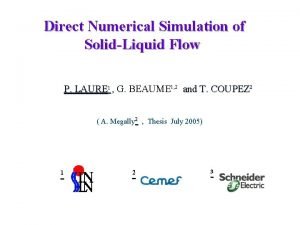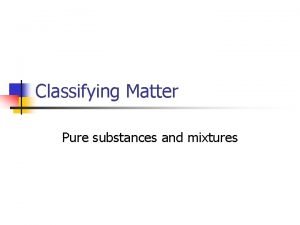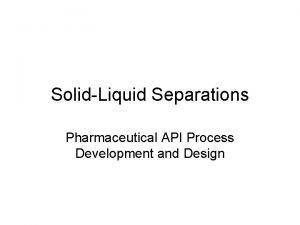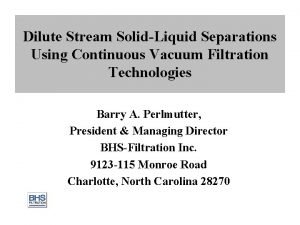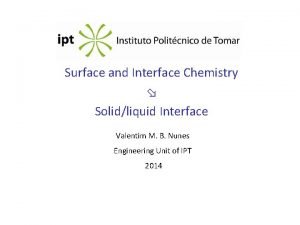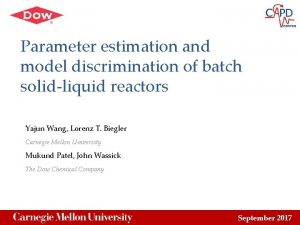SOLIDLIQUID INTERACTIONS Zeroorder reactions have a constant rate






































- Slides: 38

SOLID-LIQUID INTERACTIONS

• Zero-order reactions have a constant rate. • This rate is independent of the concentration of the reactants. • A first order reaction has a rate proportional to the concentration of one of the reactants. • A common example of a first-order reaction is the phenomenon of radioactive decay.

Zero-order reactions • A 0 -order reaction has a rate which is independent of the concentration of the reactant(s). • Increasing the concentration of the reacting species will not speed up the rate of the reaction. • In zero-order reactions a material that is required for the reaction to proceed, • Such as a surface or a catalyst, is saturated by the reactants • A reaction is zero order if concentration data are plotted versus time and the result is a straight line

First-order reactions • A first-order reaction depends on the concentration of only one reactant • (a unimolecular reaction). Other reactants can be present, but each will be zero-order.

• Solidification and melting are transformations between crystallographic and noncrystallographic states of a metal or alloy. • These transformations are of course basic to such technological applications as • Ingot casting, foundry casting, continuous casting, single-crystal growth for semiconductors, • More recently directionally solidified composite alloys

• Another important and complex solidification and melting process, often neglected concerns the process of fusion welding. • An understanding of the mechanism of solidification and how it is affected by • Such parameters as temperature distribution, cooling rate and alloying, • Is important in the control of mechanical properties of cast metals and fusion welds.

• The objective our lecture is to develop some of the basic concepts of solidification, • Apply these to the practical processes of ingot casting, continuous casting and fusion welding. • We then consider a few practical examples illustrating the casting of engineering alloys in the light of theoreticalbackground.

THE NUCLEATION OF SOLIDS IN LIQUIDS • The liquid to solid transformation occurring by a first order process is discontinuous: • The liquid does not change gradually into solid as it does in the glass transition. • Before a first order solidification process can begin, • A nucleus of the solid phase has to exist in the liquid, • Freezing then takes place by the growth of the nucleus into the melt.

• Solidification in this sense requires the simultaneous presence of both the solid and the liquid phases • An important feature of crystalline solids is that • At constant pressure they have a characteristic equilibrium freezing/melting temperature, Tm.


• The solid and the liquid phases can only be in thermodynamic equilibrium at this unique temperature. • we can also say that at the equilibrium freezing temperature • The free energies of the solid and liquid phases are equal. • At temperatures above Tm , the liquid has a lower free energy than the solid, • And the liquid is therefore the stable phase. • At temperatures below Tm the solid has the lower free energy and is therefore the stable phase.

• when a liquid reached to a temperature below its thermodynamic freezing temperature • It not immediately and spontaneously crystallize • A certain degree of “undercooling’ or ‘super cooling’ of the liquid is usually necessary before the freezing process starts. • If the undercooling is actually measured, a time— temperature graph such as is shown in Figure 3. 2 is obtained.



• The liquid first under cools an amount T, • At this temperature the solid nucleates: • Growth then proceeds with the evolution of latent heat, • The temperature rises to equilibrium freezing temperature • ( more accurately, to slightly below equilibrium freezing temperature,

• Since a small under cooling is required to drive the process in the direction of solidification. • When solidification is complete and no more latent heat is evolved, • The temperature of the solid continues to fall. • From this description of the freezing process, two questions immediately arises.

• (1) what are crystal nuclei? and • (2) why do they appear only at temperatures significantly less than the equilibrium freezing temperature? • To answer these questions we again have to consider the • i) Atomic structure of liquids and solids, • Ii) Thermodynamic energy requirements for the formation of a small crystal of the solid phase in the bulk liquid phase.


Homogeneous Nucleation • Consider a certain volume of liquid being progressively cooled. • The atoms of the liquid are in a state of constant agitation, • Therefore, the liquid exhibits no permanent long range order, • It is probable that some atoms will cluster together momentarily into small regions having the crystal structure of the solid phase (embryos). • These small clusters, called embryos, are potential nuclei for the solidification process. • We can determine if the embryos will become actual nuclei by considering the free energy changes involved in their formation.


• If GL and Gs are the free-energies per unit volume of the liquid and solid phases respectively, • the difference between GL and Gs ( Delta Gv) provides a negative energy contribution at temperatures less than TE (see Figure 3. 1). • There is, however, a positive energy term due to the creation of the solid—liquid interface. • Let gamma. SL represent the (positive) energy per unit area of the surface dividing the solid embryo from the liquid. • The change in free energy corresponding to the formation of a sphere of solid of radius r is then given by

• The important thing to notice about this equation is that the surface energy term varies as the square of the radius, • whereas the volume free energy term varies as the cube. • The change in free energy varies with the size of solid sphere in a manner shown in Figure 3. 3.


• When the solid clusters are small the surface energy term predominates; • when they are large the negative volume energy term predominates. • At the temperature to which the diagram refers, i. e. some temperature less than Tm, • A cluster is stable only when its radius is greater than r, the critical radius;

• The free energy of sub-critical clusters would have to increase if they were to grow, • This is thermodynamically impossible. • Consequently, embryos of radius less than r* disappear, • Nuclei of radius greater than r grow larger. • The critical radius can be found from the equation 4. 4 • By differentiating G with respect to r and setting the derivative equal to zero.


• It can easily be shown by differentiation of Equation 4. 4 that

• The above formulation tells us what size embryo is required to form a critical nucleus at any temperature, • But it does not say whether embryos of that size actually exist in the liquid at that temperature. • Intuitively, we would expect a range of embryo sizes in the liquid at any temperature, and

• We would further anticipate that at the higher the temperature the smaller would be the largest -size embryos • Because of the increased amplitude of atomic vibrations at the higher temperatures. • It is also reasonable to assume that the larger the volume of liquid, the greater is the probability of an embryo of critcal size existing.

• Figure 3. 4 the larger the supper cooling the smaller the critical nucleus size. • Figure 3. 5 shows the expected form of the ‘relationship between the maximum embryo size and temperature, • A relationship we could confirm if we were to follow the argument through mathematically • By superimposing Figure 3. 5 onto Figure 3. 4, • The point of intersection of the curves represents the temperature at which embryos become viable crystal nuclei.


• Figure 3. 6 is, therefore, the temperature at which solid will nucleate spontaneously in the liquid, • And is called the homogeneous nucleation temperature. • It has been found empirically that for simple liquids, such as liquid metals, • The amount of undercooling required for homogeneous nucleation • Is an approximately constant fraction of the melting point (expressed in K ) • For each material, T – O. 2 O Tm. The basic reason for this large barrier t:


• The basic reason for this large barrier nucleation is the great difference in structure between the solid and liquid phases, • The solid consisting of a regular arrangement of atoms on a crystal lattice • whereas the liquid is best described as amorphous. • Delta. T(critical) is obviously the maximum undercooling attainable • Since by definition a liquid cannot be (slowly) supercooled to a temperature less than T*

• For the high temperature metals Delta T amounts to several hundred degrees centigrade: • The homogeneous nucleation temperature of pure iron, for instance, is approximately 300 K below its equilibrium freezing temperature. • From Equation (3. 3) it can be calculated that the critical size nucleus for homogeneous nucleation contains in the region of 300 atoms

• It is known that the presence of foreign solids in the liquid, or • Even the walls of the container in which the liquid is held, • may serve to nucleate the solid heterogeneously at a temperature considerably above the homogeneous nucleation temperature. • Using the example of commercial steels cast into ingot moulds,

• we know from experience that • The solid nucleates in the vicinity of the mould walls at a temperature of only a few degrees less than the equilibrium freezing temperature • The mould walls serve to chill the liquid locally and • Thus permit small solid particles in suspension in the liquid to act as heterogeneous nucleation centres for the freezing process. • Solidification begins at the outside of the ingot and progresses inwards with time.

• The purest commercial metals and alloys always contain sufficient foreign bodies, or inclusions, • To serve as heterogeneous nucleation catalysts even if the mould walls are themselves inert in this respect. • Very rarely, and then only under the most careful experimental conditions, will a liquid supercool to its homogeneous nucleation temperature.
 Equilibrium of chemical reactions
Equilibrium of chemical reactions Big k vs little k chemistry
Big k vs little k chemistry Constant rate filtration example
Constant rate filtration example Chemical reactions section 2 classifying chemical reactions
Chemical reactions section 2 classifying chemical reactions 20 examples of redox reaction
20 examples of redox reaction Section 2 classifying chemical reactions worksheet answers
Section 2 classifying chemical reactions worksheet answers Types of reactions
Types of reactions Chemistry unit 5 reactions balancing reactions worksheet
Chemistry unit 5 reactions balancing reactions worksheet Constant pointer and pointer to constant
Constant pointer and pointer to constant üyou
üyou 9 pointers
9 pointers Metals tend to be
Metals tend to be Complex ion equilibria
Complex ion equilibria Constant to pointer in c
Constant to pointer in c Display the address of intval using cout and intptr.
Display the address of intval using cout and intptr. Is ag an ion
Is ag an ion Units of gas constant
Units of gas constant Factors that affect the rate of reactions
Factors that affect the rate of reactions 6 faces 12 edges 8 corners
6 faces 12 edges 8 corners How to calculate rate constant
How to calculate rate constant Rate law
Rate law Tray dryer calculations
Tray dryer calculations Example of constant rate of change
Example of constant rate of change Liquid is pouring into a container at a constant rate
Liquid is pouring into a container at a constant rate Constant rate
Constant rate Reaction rate constant
Reaction rate constant Principles of freeze drying
Principles of freeze drying Second order integrated rate law
Second order integrated rate law Rate constant with temperature
Rate constant with temperature Rate of change of a function
Rate of change of a function Unit of rate constant
Unit of rate constant Rate in math
Rate in math Rtsp voip
Rtsp voip Constant bit rate
Constant bit rate Second order rate constant units
Second order rate constant units During a snowstorm snow falls at a constant rate
During a snowstorm snow falls at a constant rate Falling rate period of drying formula
Falling rate period of drying formula Constant growth model adalah
Constant growth model adalah Filtering solids from liquids
Filtering solids from liquids
